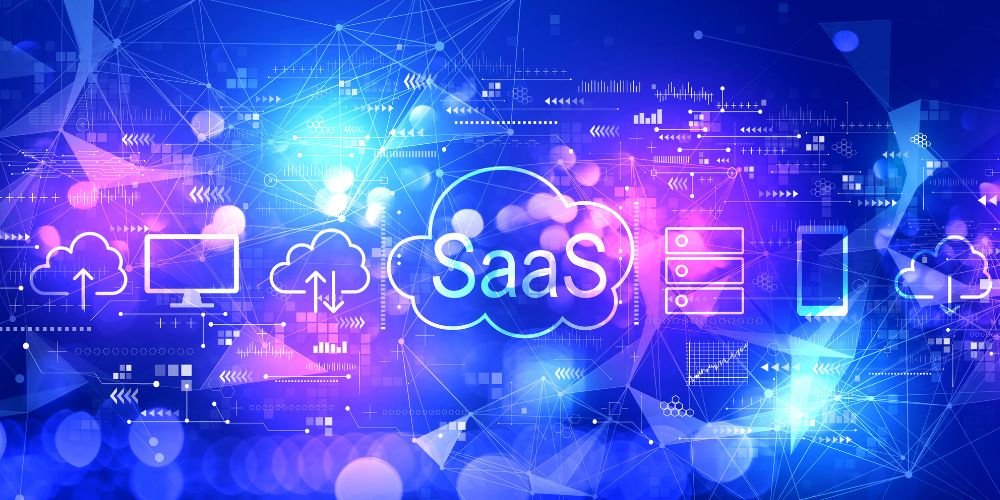Are you looking for a way to streamline your business operations, cut down on costs, and increase efficiency?
You might want to consider switching to Software as a Service (SaaS) solutions. SaaS has revolutionized the way businesses operate by providing access to a variety of software tools over the internet, eliminating the need for expensive on-premises installations.
In this article, we’ll explore the many benefits of using SaaS for businesses, including increased flexibility, scalability, and cost savings.
Whether you’re a small startup or a large enterprise, SaaS has the potential to transform the way you do business. So, let’s dive in and explore the advantages(and some of the disadvantages) of this powerful technology!
What are the benefits of using SaaS for businesses?
Now we’ve talked it up let’s look at some of the ways SaaS can transform your systems, processes and entire business for the better.
Saves money
SaaS can save some serious money for your business. Here are some real-life examples of how SaaS can lead to transformational cost savings.
Lower up-front costs
One of the primary benefits of SaaS is that it eliminates the need for businesses to make significant upfront investments in hardware, software, and infrastructure.
For example, instead of investing in expensive servers and networking equipment, a business can use a SaaS solution like Google Workspace or Microsoft Office 365 to access productivity software through the cloud.
This eliminates the need to purchase and maintain hardware, reducing upfront costs.
Reduced maintenance costs
When you use SaaS, the software vendor is responsible for maintaining and upgrading the software, which can save businesses significant amounts of money.
If a business were to use a traditional on-premises software solution, it would need to pay for ongoing maintenance and support costs, as well as pay for any software upgrades. With SaaS, these costs are typically included in the subscription fee.
Improved productivity
SaaS solutions can also help businesses save money by improving the productivity of their systems and staff.
A business that uses a project management SaaS tool like Asana can reduce the time and effort required to manage projects, freeing up employees to focus on other tasks. This increased efficiency can lead to considerable cost savings in the long run.
In conclusion, SaaS can save your business money in a number of ways, from lower upfront costs to reduced maintenance expenses and improved productivity.
By choosing the right SaaS solutions, businesses can optimize their operations and reduce their overall costs.
Scales with your business
One of the key advantages of SaaS is its ability to scale alongside a business as it grows. Here are some examples of how SaaS can scale alongside a business in real life:
Customer Relationship Management (CRM) software
A CRM system can help your business manage its interactions with customers, clients, and prospects.
As you grow, you’ll need to manage more customers and leads, which means it needs to be robust enough to grow with your needs.
SaaS-based CRM systems such as Salesforce, Zoho CRM, and Hubspot CRM can scale with the business, allowing the business to add more users, functionality, and data storage as needed.
Accounting software
Accounting is a critical function for any business and it only gets more complex as it grows, with more transactions, more customers, and more suppliers.
SaaS software like QuickBooks, Xero, and FreshBooks can scale with the business, allowing it to handle more transactions, add more users, and access more features as bolt-ons.
Project management software
Project management is essential for managing any complex task with several stakeholders.
Naturally, the larger your projects become the more comprehensive the SaaS platform needed to handle more projects, more team members, and more complex workflows.
SaaS-based project management software such as Trello, Asana, and Monday.com can scale with the business, allowing it to add more users, more projects, and more features as and when required.
Marketing automation software
Marketing automation software helps businesses automate and streamline their marketing processes.
Automation systems can handle more leads, more campaigns, and more channels than any internal marketing team ever could.
Software such as Marketo, Hubspot, and Pardot can scale with the business, allowing it to add more users, more campaigns, and more features as and when needed.
High levels of data security
Providers typically employ multiple security measures to protect their clients’ data with security being one of the primary concerns for any business.
Encryption:
Encryption is used to protect sensitive data while it’s in transit (e.g., when it’s being sent over the internet) and at rest (e.g., when it’s stored on servers). This helps ensure that only authorised parties can access the data.
Access controls:
Providers use access controls to restrict who can access their clients’ data. For example, they may require users to use strong passwords, implement multi-factor authentication, and even limit access to certain features or data based on users’ roles.
Regular security audits:
SaaS systems often undergo regular security audits (completed by external and internal teams) to identify vulnerabilities and ensure that their security measures are up-to-date and effective.
Disaster recovery:
Disaster recovery plans will be in place to help ensure that their client’s data is protected in the event of a data breach or other unforeseen circumstances.
Compliance
All SaaS providers must comply with various data protection laws and regulations, such as the GDPR and HIPAA, depending on the type of data they handle. They must also comply with industry-specific standards and certifications, such as ISO 27001 and SOC 2.
Here are some real-life examples of how some of our favourite SaaS providers handle data security and the laws and regulations they have to follow.
Dropbox
Dropbox uses encryption to protect its users’ data in transit and at rest. It also offers two-factor authentication and a remote wipe feature to help users protect their accounts in case of a security breach.
Salesforce
Salesforce is certified under several security standards, including ISO 27001 and SOC 2, and offers encryption, access controls, and regular security audits to protect its clients’ data.
HubSpot
HubSpot uses encryption to protect its clients’ data in transit and at rest, and offers two-factor authentication and access controls to restrict who can access the data. It is also compliant with GDPR and SOC 2.
Google Workspace
Google Workspace (we couldn’t live without this at Isca Brands) uses encryption to protect its clients’ data in transit and at rest, and offers two-factor authentication and access controls to restrict who can access the data.
It is compliant with several security standards, including ISO 27001 and SOC 2.
Easily accessible
Software-as-a-Service (SaaS) is so accessible because it eliminates the need for customers to purchase and maintain their own software and hardware infrastructure.
The software is hosted in the cloud and can be accessed through a web browser or a dedicated app meaning customers don’t need to invest in expensive hardware, software licenses, or IT staff.
Providers typically offer a pay-as-you-go pricing model, which allows customers to pay only for what they use. This makes SaaS more affordable for small businesses and startups that don’t have the capital to invest in expensive software and hardware infrastructure upfront.
SaaS is particularly beneficial for remote teams, as they can collaborate on the same software and data from different locations.
Trials
SaaS providers often tempt you with free trials and no upfront cost as a way to give potential customers a chance to test their software before committing to a purchase.
These trials typically last for a set period of time, such as 14 or 30 days, and give users full access to the software and its features.
To sign up for a free trial, you’ll typically need to provide basic contact information, such as your name and email address.
Some SaaS providers may require you to enter credit card information, but they’ll only charge you once the trial period is over and you haven’t cancelled your account/membership.
There are a variety of ways free trials are structured, some may offer a limited version of their software, while others provide full access to all features for a limited time.
SaaS services we love with a free trial
Now we’ve hyped you up with all the amazing ways SaaS can help you grow and run your business let’s look at some awesome free trials you can sign up to.
HubSpot
Hubspot offers a variety of marketing, sales, and customer service tools, including a free trial of their marketing software.
The trial lasts for seven days and gives users access to all of the features you need to dominate your online marketing efforts.
Canva
Canva is a graphic design platform that offers a free trial of their Pro subscription.
The trial lasts for 30 days and gives users access to additional features, such as unlimited storage and the ability to create designs with their expensive range of templates.
This one is a must-have for anyone looking to get creative for little to no cost.
Salesforce
Salesforce is a customer relationship management (CRM) platform that offers a free trial.
The trial lasts for 30 days and gives users access to all of the features of the software, including sales, marketing, and customer service tools.
Perfect for anyone looking to increase their sales and marketing outreach.
Zoom
Zoom is a video conferencing platform that offers a free trial to their Pro subscription.
The trial lasts for 30 days and gives users the ability to host meetings with up to 100 participants and backs it up using cloud storage for recorded meetings.
Perfect for remote teams and online coaching at scale.
Trello
Trello is a project management platform that offers a free trial of their Business Class subscription.
The trial lasts for 14 days and gives users the ability to create boards and tasks while assigning users seamless communication and a user-friendly UX.
Are there any disadvantages to using SaaS for your business?
While SaaS is incredibly helpful overall there are some pitfalls you should be aware of.
Security and privacy concerns
SaaS applications are hosted in the cloud, meaning users are relying on the provider to secure and protect their data.
While most SaaS providers have robust security measures in place, there is always a risk of data breaches or other security issues.
One example of this was in 2021, the SaaS provider, Kaseya, experienced a ransomware attack that impacted more than 1,500 businesses that relied on their software.
Limited customization options
SaaS applications are designed to be used by a wide range of users, which means that they may not be as customizable as on-premises software with one specific business or organisation in mind.
Internet dependency
SaaS software relies on a stable internet connection to function properly. If there is an internet outage or a slow connection, it can impact productivity and access to critical business data.
Vendor lock-in
SaaS applications are often licensed on a subscription basis, so organizations may become reliant on a particular vendor or software.
This can create a sense of vendor lock-in, which can be challenging if the vendor decides to change their pricing or licensing model or if the organization decides to switch to a different software.
If an organization relies heavily on a specific SaaS application, switching to a different platform may require significant time, effort, and cost.
Data ownership
SaaS applications store data in the cloud, which can create questions around data ownership and control.
Organizations may have a different level of control over their data than they would with on-premises software, which can create challenges if the organization needs to comply with certain regulatory requirements or if they need to retrieve their data from the provider.




